Texas Railroad History - Tower 45 - Malone
A Crossing of the
International & Great Northern Railroad and the Trinity & Brazos Valley Railway
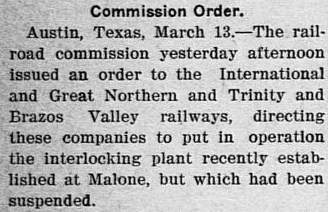 |
Right: This
drawing of Tower 45 is from
Two Trains Crossed, A History of Malone and Its
People, 1904 - 1984 (courtesy of Cody Newman).
The tower is briefly mentioned as "... a small building two stories tall with
windows all around and lots of machinery inside." The operators are
identified as "Mr. Lucas and later his son Ralph." This is the first
independent confirmation that the tower at Malone was a two-story manned
structure. A photo of this tower has not been located.
Left:
This snippet of an article from the Palestine Daily Herald dated March
14, 1908 states that RCT had ordered the two railroads to put the Malone
interlocking back into service after some period of being "suspended".
It also describes the interlocker as being "recently established"
although the RCT files list a commissioning date nearly four years
earlier. The reasons for the suspension are unknown. |
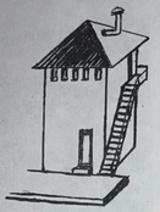 |
Thirty miles northeast of
Waco, Alonzo Dru Walling founded a settlement on his
land in 1884 and named
it Walling. The community relocated two miles eastward in 1902 to become a stop
on the International & Great Northern (I-GN)
Railroad which was completing a lengthy main line
between Spring (near Houston) and Fort Worth. About this same time, the Trinity and Brazos Valley
(T&BV) Railway was chartered to build a rail line from
Cleburne to Beaumont.
Within a year, T&BV construction was in progress southeastward out of
Hillsboro toward
Hubbard and it would cross the I-GN a couple of
miles southwest of Walling. Recognizing the economic advantage of being served
by two railroads, Alonzo Walling and other landowners approached the T&BV about
putting a station at the junction around which they
would establish a new town. As an incentive, they offered to give the T&BV an interest in their land
development. An agreement was reached and an auction for town lots was conducted
on December 2, 1903. The new town of Malone was named after William Malone, but
... who was William Malone?
The Handbook of Texas, in its history of the
town of Malone, describes William Malone as president of the I-GN.
A. D.
Walling, seeing the economic potential of a community served by two railroads,
overcame the hostility of William Malone, president of the I-GN, toward a
competing rail line in the area by suggesting the establishment of a new town,
which would allow Malone's line to maintain its control of rail traffic in
Walling. The new settlement, where the two lines would intersect, was to be
called Malone and was located on farmland owned by A. D. Walling, just west of
the town that bore his name. Walling and a few other investors surveyed the new
community and divided it into lots, which were sold at public auction on
December 2, 1903. Officials of both the I-GN and the T&BV lines were given an
interest in the sale of property in Malone, and directors of the latter line
agreed to build a station there. The new community grew immediately, its
population standing at 125 on the day of the public auction. In addition, a
cotton gin, a lumberyard, and a school already operated there. A post office
opened that year. A. D. Walling ensured the growth of Malone through litigation
that forced officials of the International-Great Northern to build a station and
schedule regular stops in the new community.
There are parts of this passage that make
little sense. Why would "...the establishment of a new town...allow Malone's
line to maintain its control of rail traffic in Walling..." ? The T&BV was
not building through Walling so I-GN's control of rail traffic there was not
threatened, except that Walling would lose commerce to the new town that would
be served by two railroads if I-GN agreed to put a station there. More
critically, if Alonzo Walling successfully "overcame the hostility
of William Malone" in the founding of the new town, and I-GN officials were
"...given an interest in the sale of property in Malone...", why was
there a need for "...litigation that forced officials of the International -
Great Northern to build a station and schedule regular stops in the new
community." ? Wouldn't I-GN officials have embraced the new town in
which they had a financial interest since, if it was served by two railroads, Malone was
destined to become substantially larger than Walling which only had
I-GN service? The Handbook of Texas
lists as references for this information a Hillsboro Mirror
news article from 1930 and a publication by the Hill County Historical
Commission, but there are no additional details. Neither of these original
sources have been located thus far.
Perhaps the Handbook
of Texas editors never noticed that they also mention William Malone in an article describing the founding of
the T&BV...
The Trinity and Brazos
Valley Railway Company was chartered on October 17, 1902, to construct a
railroad from some point in Johnson County in a southeastern direction to the
Beaumont area. The capital stock was $300,000. Although the principal office was
originally located at Hillsboro, it was moved to Cleburne and Fort Worth in 1906
and to Houston in 1908. Members of the first board of directors were S. R.
Wrightington and Stephen E. Young, both of Boston, Massachusetts; Edward M.
House, Robert H. Baker, and E. Sammons, all of Austin; Thomas W. House and John
H. B. House, both of Houston; J. C. McDowell of Pittsburg, Pennsylvania; and
William Malone of San Marcos.
So...were there two men named William Malone
involved in the founding of the town, one from each railroad? That's possible, but it seems
improbable. And while railroad investors were sometimes involved in multiple
companies, it seems unlikely that a single individual named William Malone was
simultaneously the president of the I-GN and a founder of a competing railroad,
the T&BV [particularly since William Malone was also the right-of-way agent for
the T&BV; the president of the I-GN would not simultaneously be functioning
as the manager of the land office of another railroad.]
As noted above, in addition
to William Malone, the T&BV's first Board of Directors included Edward M.
House and his brothers Thomas W. House and John H. B. House. Their father was
Thomas W. House, Sr., a major financier during the early period of Texas railroading and the owner of a
massive sugar cane plantation near Sugarland.
Edward M. House eventually became a famous U.S. diplomat and close advisor to
President Woodrow Wilson. A 1964 biography of his early years,
Colonel Edward M. House: The Texas Years, 1858 - 1912
written by noted Texas historian Rupert Norval Richardson mentions that "...William Malone, manager of House's farms, was to be right-of-way
agent..." for the T&BV. It also explicitly states that the town of Malone was "...named after William Malone of San
Marcos, Texas, a brother-in-law of E. M. House." William Malone's role as
the T&BV's right-of-way agent is confirmed by a reference in The Railway Age published April 6,
1906 which noted that... "Mr. William Malone, in addition to performing the duties
of right of way agent of the Trinity & Brazos Valley, has assumed the duties of
claim, tax and insurance agent, with office at Cleburne, Tex." This is
consistent with the Handbook of Texas' notation that the T&BV's
offices were initially in Hillsboro, but were relocated to Cleburne in 1906.
No similar objective references for William Malone as president of the I-GN
have been found. Most critically, author Wayne Cline, in his definitive history
of the I-GN, The Texas Railroad, The Scandalous and
Violent History of the International and Great Northern Railroad, 1866 - 1925
((c) 2015, Wayne Cline) manages to write 339 pages of I-GN history
without ever mentioning William Malone, as
President or in any other capacity! This is the nail in the coffin of the
version of Malone's naming that appears in the
Handbook of Texas.
There can be little doubt that the town of Malone was named for the William Malone that
served as the T&BV's right-of-way agent and a member of its Board of Directors.
Without additional evidence, the Handbook of Texas' article to the contrary appears to be simply incorrect.
Furthermore, recognizing William Malone as the T&BV's right-of-way agent and
not the president of the I-GN makes the
Handbook's article more plausible. For the T&BV, William Malone might have
initially resisted the approach of Alonzo Walling simply as a means of
negotiating for favorable terms as a partner in the land auction (a strategy
that clearly succeeded.) In contrast, the I-GN would have resisted the
establishment of the new town regardless since they had exclusive land interests
at Walling that would be jeopardized by the growth of Malone. Hence, it makes
sense that Alonzo Walling had to resort to litigation against the I-GN to force
them to build a station at Malone (and thus, it seems plausible that the I-GN
did not participate in the land auction
agreement, contrary to the Handbook's story.)
The precise location of the
community of Walling has not been determined, but it is known to have had a
station along the I-GN tracks. Presumably, it was very close to the Walling
Cemetery which still exists (at 31 56 49 N, 96 52 48 W.) A Texas Historical
Marker for Malone notes that "St. Peter's Lutheran Church was founded July
1, 1906 at Walling" and this church still stands near the Walling Cemetery.
This places Walling approximately two miles northeast of Malone. While the T&BV
built a depot to serve Malone, the I-GN resisted doing so, attempting to
preserve the viability of the Walling community as its area railroad stop. A locally published manuscript titled
Two Trains Crossed, A History of Malone and Its
People, 1904 - 1984 (provided courtesy of Cody Newman) describes the
conflict that ensued once the T&BV rails were laid through Malone.
As soon as the
railroad was built a fight started between the towns of Malone and Gehring, the
town earlier called Walling. The railroad fight was so great that when the I&GN
train would pass through Malone it was compelled to stop because of a gate that
had been erected across the tracks. The conductor would lock all doors and the
passengers who wanted to get off at Malone would have to go to Gehring and find
a way back to Malone. The I&GN, which owned the townsite of Walling/Gehring, was
interested only in its success. It refused to make a stop at Malone. A. D.
Walling made several trips to Austin before the Railroad Commission. Finally he
persuaded them to force the I&GN Railroad to build a station in Malone. After
the station was built, Gehring faded away.
From this passage, it is apparent that the
impetus for the I-GN to build a station in Malone came not from direct
litigation, but rather from Alonzo Walling's appeals to the Railroad Commission
of Texas (RCT). This makes more sense than a lawsuit; using the RCT's regulatory
powers would have been much quicker than using the judicial system.
The "gate that had been erected across
the tracks" was installed for a reason unrelated to the conflict between A.
D. Walling and the
I-GN. This was a swing gate used as a substitute
for an interlocker to protect the crossing. The description implies that the
gate was normally lined against the I-GN. I-GN trains would stop while someone
(either a member of the train crew or a railroad employee) would open the gate
and swing it across the T&BV tracks. The train would proceed over the crossing
diamond and the gate would be returned to its normal position
against the I-GN tracks. That the I-GN train conductor
reportedly locked all of the passenger cars' doors while the gate was being opened indicates
that the I-GN was adamant about requiring its passengers to only get on and off
at the Walling station.
Lining the gate against the I-GN made sense in the early days because all T&BV
trains would be stopping at the Malone station anyway. The station was only a few
hundred yards west of the crossing, hence leaving the gate closed against the
I-GN (and thus open for the T&BV) allowed eastbound T&BV trains to pull
slowly away from the station without having to stop a second time to open the
gate. Similarly, westbound trains were allowed to cross the I-GN slowly as they
were reaching the station without needing to make an extra stop to open the
gate.
The gate did not last long; RCT
authorized operation of a mechanical interlocker at Malone on July 7, 1904
housed in a two-story manned structure known as Tower 45. [Which quadrant of the
diamond the tower occupied has not been determined.] Tower 45's commissioning
was during a busy period for the construction of manned interlocking towers
throughout Texas; 28 were opened in calendar year 1904 alone. The I-GN was the
senior company at this crossing, i.e. there was no crossing at all until the
T&BV built across the I-GN. As such, the I-GN had the legal right to demand that
an interlocker be installed, with the capital expense of the tower's design and
construction borne by the T&BV. The two railroads would then share the cost of
staffing and maintaining the tower since it benefitted both companies.
State law
required all trains to stop at uncontrolled crossings before proceeding. The I-GN
wanted the interlocker because it would improve its train speeds through Malone
by eliminating the need to stop unless the crossing was actually occupied.
Walling was a very small community while the I-GN was a major Texas railroad
moving tons of freight between major cities. Unlike the T&BV at Malone, most
I-GN trains would not be stopping at Walling (nor at Malone, for that matter,
when the I-GN station was built there.) Lengthy freight trains needed to keep
moving, only making water stops where necessary. The Tower 45 interlocker
allowed most I-GN trains to pass through Malone without incurring the sizable
time penalty of slowing to a complete stop and then slowly accelerating back to
normal speed.
The interlocking plant in Tower 45 was built by Union Switch &
Signal Co. of Pittsburgh, PA. It had a 12-function capacity, but at the time of
installation only 11 functions were used. The normal minimum for an interlocker
was 12 functions: four home signals, four distant signals and four derails. For
Malone, the eastbound distant signal for the T&BV was most likely eliminated. In
those early days, there was no need for a distant signal to warn eastbound T&BV
trains to prepare to stop at the crossing since they would be stopping at the
Malone depot before reaching the crossing. A signpost a mile or so west of Malone
would have been sufficient to remind approaching trains to slow for the Malone
station. Having stopped at the depot, the
eastbound home signal would be visible to control movement across the diamond
when the train departed.
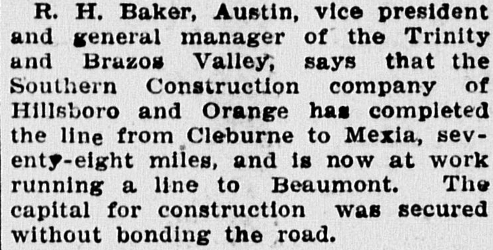 |
Left:
A Dallas newspaper, The Southern Mercury,
reported in its November 12, 1903 edition that the T&BV line had been
completed between Cleburne and Mexia. RCT records show this construction was completed in 1904.
There's no evidence that "...work running a line to Beaumont." ever
occurred, so the veracity of the claim of having reached Mexia may also
be in question. Railroad promoters were the pioneers of "fake news".
Right:
The Southern Mercury
reported the conflict between Malone and Walling in
this news item in their December 24, 1903 edition. The Malone crossing
was interlocked six months later. |
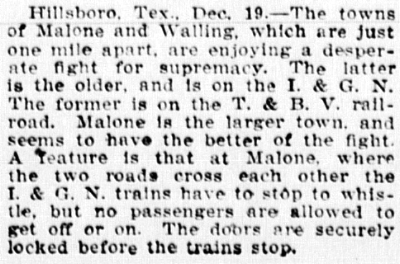 |
The T&BV line through Malone was part of a route originally constructed between
Cleburne and Mexia. It
never reached its original target, Beaumont, because it was taken over by B. F.
Yoakum in 1905 and redirected to become a lengthy north/south route through
Teague connecting
Yoakum's railroads in Houston with those in north
Texas via Waxahachie and trackage rights into
Dallas. Eventually, as Yoakum's rail
enterprise failed financially and splintered into its separate components, the T&BV remained operational during
its lengthy receivership that began in 1914.
When it ended in 1930, a new railroad, the Burlington - Rock Island Railroad,
was established to take over the T&BV's assets. By this time, the growth of the
rail network in Texas had rendered the line between Cleburne and Mexia
unnecessary. The T&BV
rails through Malone were abandoned in 1935 and Tower 45 was decommissioned at that
time. For the entire route between Cleburne and Mexia, Texas Highway 171 was
built and sits parallel to or directly atop the T&BV grade in many places. The I-GN line
through Malone had a much longer life as part of the Missouri Pacific's line
from Waco to Ft. Worth and was not abandoned until 1967. Remnants of the I-GN,
particularly concrete bridges, are easily spotted from Farm Road 308 north and
south of Malone.

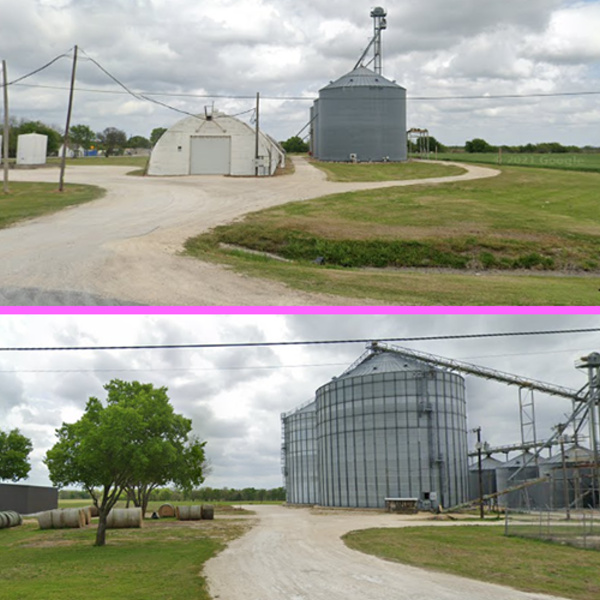
Above Left: The Chief Engineer of
the Missouri Kansas Texas Railroad maintained track charts for many railroad
junctions in Texas, even those that did not involve his railroad. This chart of
the Malone junction dates from 1915 and shows the location of the two railroad
stations. It also shows a transfer track in the southwest quadrant of the
crossing which also has a spur leading to the back side of the I-GN station.
Above Right: (Top) Looking north
from the approximate site of the Tower 45 crossing diamond, the I-GN
right-of-way passed between the white warehouses and the gray grain silos.
(Bottom) Looking south, the I-GN right-of-way ran down the road between the
trees and the silos.
Tower 45 Location Map
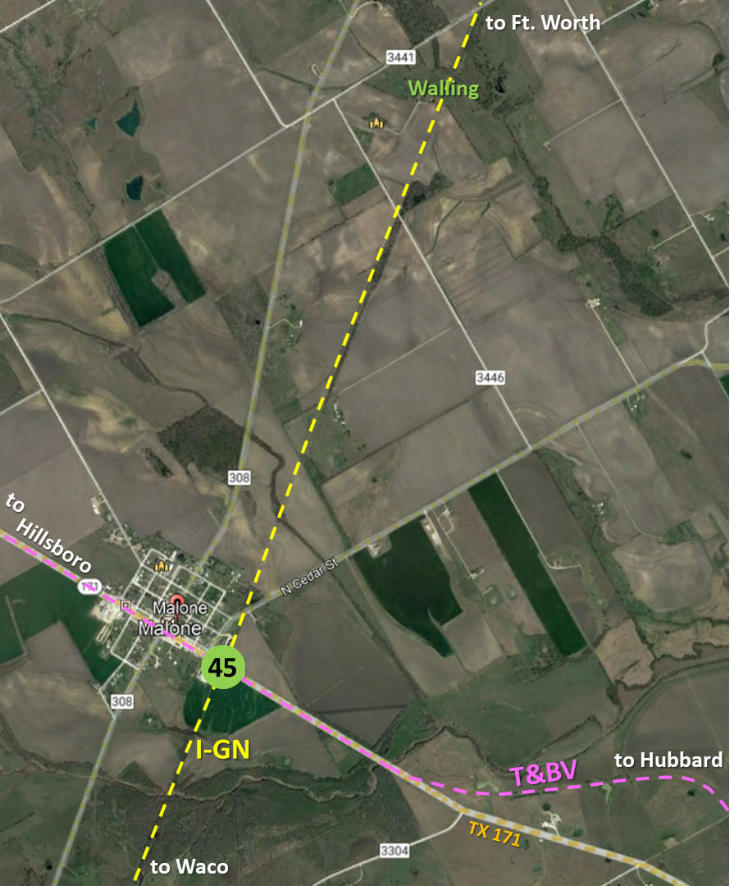
Above: Tower 45 was located on
the east side of Malone. Decades of development and highway construction since
its decommissioning in 1935 have
obliterated any traces of the tower or its foundation.






